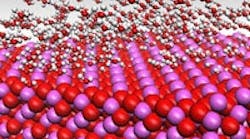A thin layer of alumina more than doubles the critical heat flux in pool boiling heat transfer, report researchers at Georgia Institute of Technology, Atlanta. Moreover, the nano-coating not only improves energy efficiency but also should prevent corrosion of the underlying surface, notes Bo Feng, a research engineer in the school of mechanical engineering who is leading the work.
Pool boiling can provide efficient heat transfer until a critical heat flux is reached, at which point bubbles coalesce to prevent rewetting of the heated surface, explain the researchers. The superwetting property of the alumina coating (Figure 1) enables much higher heat flux before rewetting becomes a problem. "This is the primary reason for the enhancement of heat transfer," says Feng. The results underscore the more-general promise of using hydrophilic coatings to promote boiling heat transfer, he adds.
The researchers used atomic layer deposition (ALD) to put a 20-nm coating on a platinum wire. They now have deposited coatings on flat silicon surfaces, to check their potential for removing heat from semi-conductors. Tests should take about six months, says Feng.
ALD can coat most clean solid surfaces (metal, plastic, semi-conductor, etc.) as long as the solid can withstand 100°C, he notes. It can deposit coatings of materials other than alumina. At the moment, the researchers only can coat up to a 6-in.-dia. surface. "But, in principle, there is not a limitation for coating size."
The cost to deposit a coating is an issue, but Feng foresees the potential for significant cost reduction.
Tests currently use de-ionized water so it may be a challenge to maintain performance using regular water and other industrial fluids, he admits. In addition, the researchers don't yet know about the long-term robustness of the coatings but now are looking into this.
Feng is interested in cooperating with equipment makers to test the technique on a small-scale heat exchanger.


